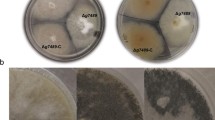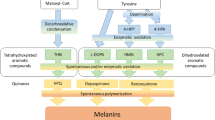Abstract
Conidiophore formation and sporulation can be induced inPenicillium sp. strain P 17 by an environmental factor—carbohydrate (carbon) starvation. Both surface and submerged mycelium, when transferred from synthetic medium to glucose-free salt solution, form conidiophores and sporulate, while in the control cultures on complete medium, vegetative growth continues. The time required for the formation of conidiophores, i.e. the induction interval, is 7–14 h and its length increases with the age of both surface and submerged mycelia. During the induction phase the mycelium undergoes autolysis, associated with degradation of energy motabolism involving the comsumption of reserve substances, a rapid drop in endogenous respiration and the endogenous reducing activity of the mycelium, a decrease in the labile phosphate concentration, proteolysis, an increase in the ammonia and orthopsphate concentration and exhaustion of readily oxidized amino acids from the pool. A transient increase in respiration occurs before differentiation of the conidiophores starts. During the second half of the induction phase, polyphenol substances and polyphenol oxidase appear in the mycelium.The enzyme is not induced by exogenous phenols. Its possible role in the sporulation of fungi is considered.
Similar content being viewed by others
References
Arnow, E. L.:Colorimetric determination of the components of 3,4-dihydroxyphenylalanine-tyrosine mictures. J. biol. Chem. 118: 531, 1937.
Behal, J. F., Eakin, R. E.:Inhibition of mold development by purine and pyrimidine analogs. Arch. Biophys. 82: 439, 1959.
Bent, K. J., Morton, A. G.:Amino acid composition of fungi during development in submerged culture. Biochem. J. 92: 260, 1964.
Bradley, S. G., Sussman, M., Ennis, H. L.:Environ mental factors affecting the aggregation of the cellular slime mold. Dictyostelium discoideum. J. Protozool. 3: 33, 1956.
Cantino, E. C.:The relationship between biochemical and morphological differentiation in non-filamentous aquatic fungi. In:Microbial reaction to environment. 11th Symp. Soc. Gen. Microbiol, ed. G. G. Meynell, H. Gooder, Cambridge Univ. Press, Cambridge, p. 243, 1961.
Chattaway, F. W., Toothill, C., Barlow, A. E. J.:The amino acid metabolism of Microsporum canis. J. gen. Microbiol. 28: 721, 1962.
Drywood, R.:Estimation of sugars with anthrone reagent. Ind. Eng. Chem. Anal. Ed. 18: 499, 1946.
Foester, J. W., Perry, J. J.:Intracellular events occurring during endotrophic sporulation in Bacillus mycoides. J. Bacteriol 67: 295, 1954.
Giri, K. V., Nigam, V. N.:Separation of simple saccharides and oligosaccharides by circular paper chromatography. Naturwissenschaften 40: 343, 1953.
Gottlieb, D., van Etten, J. L.:Biochemical changes during the growth of fungi. I. Nitrogen compounds and carbohydrate changes in Penicillium atrovenetum. J. Bacteriol 88: 114, 1964.
Gottlicb, D., van Etten, J. L.:Changes in fungi with age. J. Bacteriol 91: 161, 1966.
Hatano, S., Takeuchi, I.:ATP content in myxomycete plasmodium and its levels in relation to some external conditions. Protoplasma 52: 169, 1960.
Horwitt, B. N.:Determination of inorganic phosphorus by means of stannous chloride. J. biol. Chem. 199: 537, 1952.
Johnson, G., Schaal, L. A.:Relation of chlorogenic acid to scab resistance in potatoes. Science 115: 627, 1952.
Kalinin, F. L.: Embryonic development of plants. (In Russian.) Izd. Ukr. Akad. Selsk. Nauk. Kiev 1959.
Kirby-Berry, H., Cain, L.:Paper chromatographic technique for determination of amino acids in the presence of interfering substances. Arch. Biochem. 24: 179, 1949.
Knight, S. C.:The l-amino acid oxidase of molds. J. Bacteriol 55: 401, 1948.
Kretovič, V. J.:The biosynthesis of dicarboxylic amino acids and enzymic transformations of amides in plants. Adv. Enzymol. 20: 319, 1958.
Krichevsky, M., Wright, B. E.:Environmental control of the course of development in Dictyostelium discoideum. J. gen. Microbiol. 32: 195, 1963.
Krishnan, D. S., Damle, S. P., Bajaj, V.:Studies on the role of metaphosphate in molds. II. Formation of soluble and insoluble metaphosphates in Aspergillus niger. Arch. Biochem. Biophys. 67: 35, 1957.
Levy, M.:Titrimetric methods for amino acids. In:Methods in Enzymology, ed. S. P. Colowick, N. O. Kaplan, Acad. Press, New York vol. III, p. 455, 1955.
Lyr, H., Luthard, W.:Induction of tyrosinase in higher fungi. Nature 207: 753, 1965.
Pillai, N. C., Srinivasan, K. S.:The amino acid metabolism of Aspergillus flavus. J. gen. Microbiol. 14: 248, 1956.
Schaeffer, P., Millet, J., Aubert, J. P.:Catabolic repression of bacterial sporulation. Proc. nat. Acad. Sci. U.S. 54: 704, 1965.
Schulz, G.:Der Einfluss einiger Schwermetallsalze (Zn, Cd, Mn, Fe) auf die chemische Zusammensetzung von Aspergillus niger. Planta 27: 196, 1938.
Smithies, W. R.:Chemical composition of a sample of mycelium of Penicillium griseofulvum Dierckx. Biochem. J. 51: 259, 1952.
Sussman, M.:Developmental phenomena in microorganisms and in higher forms of life. Anual Rev. Microbiol. 19: 59, 1965.
Wang, C. H., Stern, J., Gilmour, C. M., Klungsoyr, S., Reed, D. J., Bialy, J. J., Christensen, B. E., Cheldelin, V. H.: J. Bacter. 76: 207, 1958 (cit. V. H. Cheldelin,Metabolic Pathways in Microorganisms, J. Wiley and Sons, New York and London, 1961).
Yanagita, T., Kogané, F.:Growth and cytochemical differentiation of mold colonies. J. gen. appl. Microbiol. (Tokyo) 8: 201, 1962.
Yanagita, T., Kogané, F.:Cytochemical and physiological differentiation of mold pellets. J. gen. appl. Microbiol. 9: 179, 1963a.
Yanagita, T., Kogané, F.:Cellular differentiation of growing mold colonies, with special reference to phosphorus metabolism. J. gen. appl. Microbiol. 9: 313, 1963b.
Author information
Authors and Affiliations
Rights and permissions
About this article
Cite this article
Jičínská, E. Note on study of the sporulation of fungi: endotrophic sporulation in the genusPenicillium . Folia Microbiol 13, 401–409 (1968). https://doi.org/10.1007/BF02869190
Received:
Issue Date:
DOI: https://doi.org/10.1007/BF02869190




